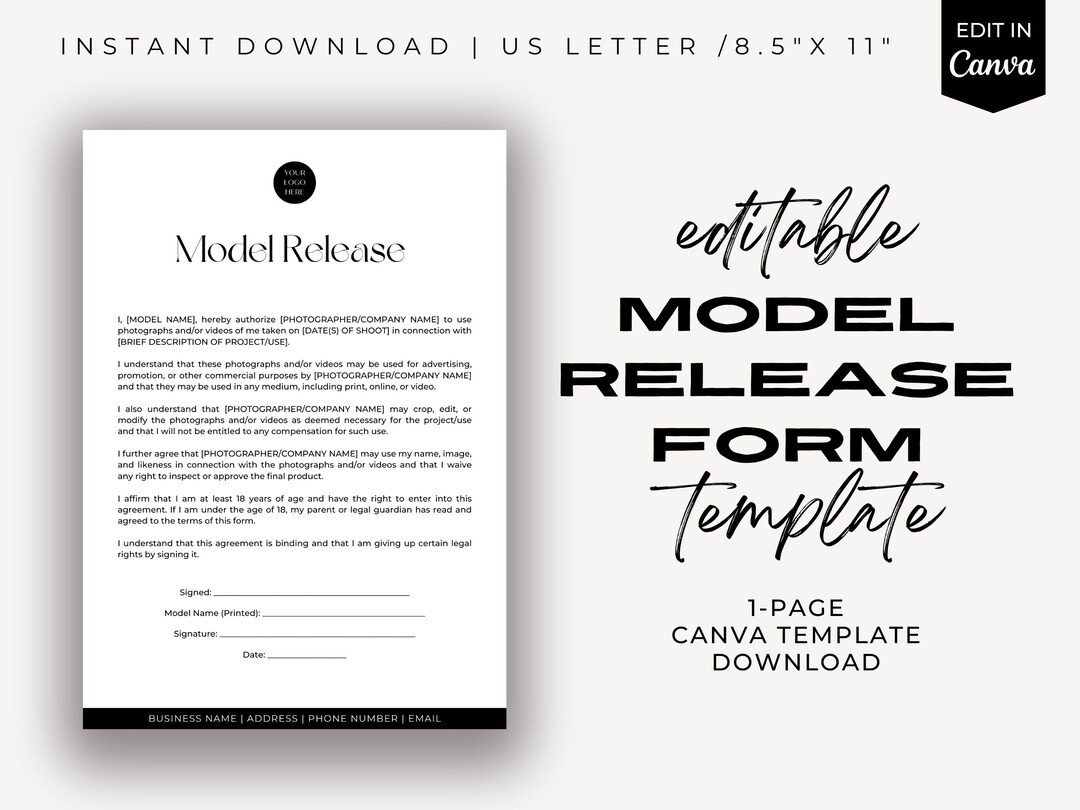If you’re into photography or videography and want to share your work on platforms like Shutterstock, understanding the importance of a model release form is essential. Essentially, a model release is a legal document that grants permission to use someone’s likeness in your images or videos. Without it, you might run into legal issues, especially if someone objects to their image being used commercially. For Shutterstock, having clear, signed model releases can make the difference between your content being accepted or rejected, ensuring your work is protected and can reach a wider audience. Think of it as a handshake that confirms everyone’s on the same page about how the images will be used.
Understanding Shutterstock’s Requirements for Model Releases

Before you start collecting signatures, it’s crucial to understand what Shutterstock specifically requires for model releases. Shutterstock has strict guidelines to ensure all content is legally safe for commercial use. Here’s what you need to keep in mind:
- Complete Information: The release must include full names, contact details, and signatures of the model (or parent/guardian if the model is a minor).
- Clear Identification: The form should clearly describe the images or videos being released, including details like date, location, and context.
- Legality and Consent: The model must understand and agree to the specific use of their likeness for commercial purposes.
- Signatures and Dates: Proper signatures with dates are mandatory; unsigned forms are invalid.
Additionally, Shutterstock prefers releases to be written in a language that the model understands clearly, ensuring informed consent. For minors, a parent or guardian must sign on their behalf, and sometimes, additional documentation may be required to verify their authority to do so.
It’s also a good idea to keep digital copies of signed releases, especially since online submissions are common. Make sure the forms are legible, correctly filled out, and stored securely. Remember, failure to provide valid model releases can lead to rejection of your images or even legal trouble down the line. So, taking the time to understand and meet Shutterstock‘s requirements is a smart step toward building a successful portfolio.
Key Elements to Include in a Model Release Form

When you’re putting together a model release form, there are some essential elements you absolutely want to include to make sure it’s clear, legal, and protects both you and your model. Think of it as the blueprint for a smooth photography session and future usage rights.
Here are the key elements you should include:
1. Basic Information
- Model’s Full Name: To clearly identify who is giving permission.
- Model’s Contact Details: Phone number and email address.
- Photographer/Creator’s Details: Your name and contact information.
2. Details of the Photos
- Description of the Photos: Date, location, and type of shots taken.
- Usage Rights: Specify what the images will be used for (e.g., commercial, editorial, personal use).
3. Consent and Release
This is the core of the form. It states that the model agrees to the use of their image and waives any future claims or royalties. Make sure it’s clear that the model understands and consents to:
- The specific uses of their images.
- Any potential modifications or edits.
- The duration of the release (perpetual or limited).
4. Legal Language and Signatures
- Statement of Consent: A clear declaration that the model agrees to the terms.
- Signature and Date: Space for the model’s signature and date signed.
- Signature of Photographer/Creator: To validate the agreement.
- Witness or Notary (Optional): For added legal protection, especially for commercial shoots.
5. Additional Clauses (Optional but Recommended)
- Restrictions on use (e.g., no use in certain contexts).
- Clauses about minors (if the model is under 18, parental consent is needed).
- Compensation details, if any.
Remember, the goal is to make the form comprehensive but easy to understand. Clear language helps prevent misunderstandings and ensures that everyone is on the same page.
Step-by-Step Instructions on Creating a Model Release Form
Creating a model release form might seem daunting at first, but if you follow these simple steps, you’ll have a professional document ready in no time. Here’s a step-by-step guide to help you through the process:
Step 1: Gather Necessary Information
Start by collecting all the details you need:
- Personal info of the model (name, contact info).
- Your own contact info and details about the shoot.
- Details about the photos, like date, location, and purpose.
Step 2: Draft the Basic Structure
Use the key elements we discussed earlier to outline the form. You can do this in a word processor or a template. Make sure to include sections for:
- Model Information
- Photo Details
- Consent Statements
- Signatures and Dates
Step 3: Write Clear and Concise Language
Keep the language straightforward. Avoid legal jargon that might confuse your model. For example, instead of saying “hereby grants,” you might say “I give permission for my photos to be used.” Clarity helps ensure everyone understands what they’re agreeing to.
Step 4: Include a Consent Statement
This is the core of your form. For example:
“I, [Model’s Name], hereby give permission for [Photographer’s Name] to use my photographs for any lawful purpose.”
Step 5: Add Signature Lines and Date Fields
Leave space for signatures and dates. If possible, include lines for a witness or notarization if needed. For minors, include a section for parental or guardian consent.
Step 6: Review and Customize
Double-check your form for clarity, completeness, and legal soundness. Tailor it to your specific needs, especially if you plan to use the images commercially.
Step 7: Save and Distribute
Save your form as a PDF to prevent editing. When you work with models, have them fill out and sign the form before the shoot begins. Digital signatures are acceptable if legally valid in your jurisdiction.
Final Tip:
Consider consulting a legal professional to review your form, especially if you’re planning to use images for commercial purposes or if you want to ensure full legal compliance. Better safe than sorry!
By following these steps, you’ll create a solid, clear, and professional model release form that protects your work and respects your models’ rights. Happy shooting!
Sample Template for a Shutterstock Model Release Form
Creating a clear and professional model release form is essential when submitting photos to Shutterstock. To make things easier, here’s a simple sample template you can customize to fit your needs. Remember, the goal is to get clear consent from your model, so be sure to include all necessary details.
Sample Model Release Form
Model Release Form for Shutterstock SubmissionPhotographer's Name: ___________________________ Date: ___________________________ Model's Name: ___________________________ Date of Birth: ___________________________ Description of the Photo/Work: (Briefly describe the photo or project, e.g., "portrait of Alex at Central Park.") _________________________________________________________ _________________________________________________________Consent Statement: I, the undersigned, hereby grant permission to the photographer and Shutterstock to use, publish, and distribute the photograph(s) listed above for commercial and editorial purposes. I understand that my likeness may appear in promotional materials, online platforms, and other media. Rights & Usage: I understand that I will not receive royalties and that the images may be used worldwide and in perpetuity. Signature of Model: ___________________________ Date: ___________________________ Parent/Guardian Signature (if under 18): ___________________________ Relationship: ___________________________ Date: ___________________________ (Optional: Add a section for witness signatures or additional clauses depending on your specific needs.)
Make sure to customize this template with your details, and double-check that it covers everything required by Shutterstock and your local laws. Clear language and explicit consent are key to avoiding any future headaches!
How to Get Signatures and Store Your Completed Release Forms
Once you have your model release form ready, the next step is to get it signed and safely store it. This process might seem straightforward, but doing it properly ensures that you’re protected and ready to submit your images confidently.
Getting Signatures
- In-Person Signing: The most traditional method is to have your model sign the form in person. This way, you can answer any questions they might have and ensure they understand what they’re signing.
- Digital Signatures: If your model isn’t local or prefers a contactless approach, using digital signature platforms like DocuSign, Adobe Sign, or HelloSign makes it easy. These tools allow for legally binding signatures and streamline the process.
- Mail or Email: You can also send the form via email or postal mail for your model to sign and return. Just make sure to follow up to confirm receipt and that the signed form is complete.
Storing Completed Release Forms
After collecting signatures, it’s crucial to store these forms securely. Here are some tips:
- Digital Storage: Save scanned copies or digital PDFs of all signed forms in a dedicated, backed-up folder on your computer or cloud storage (Google Drive, Dropbox, etc.). Use clear naming conventions like “ModelName_Date_Release.pdf” for easy retrieval.
- Physical Storage: If you prefer paper copies, keep the signed forms in a physical file or binder, ideally in a locked cabinet to protect sensitive information.
- Keep Copies: Always have multiple copies — one digital and one physical — in case of loss or damage.
- Organize and Track: Maintain a log or spreadsheet listing all models, dates, and file locations. This makes it easier to find the right release form when you need it for your Shutterstock submissions.
Legal and Privacy Considerations
Remember, protecting your models’ privacy and your own legal interests is vital. Only store signed forms for as long as necessary, and ensure they are accessible only to trusted individuals. If you’re working with multiple models regularly, establishing a consistent system for managing release forms will save you time and stress down the line.
In short, getting signatures is about clear communication and respecting your models’ rights, while storing them securely ensures you’re prepared for any future needs or questions from Shutterstock or legal entities. Happy shooting and releasing!
Common Mistakes to Avoid When Preparing a Model Release Form
Creating a model release form might seem straightforward at first, but there are some common pitfalls that can trip you up if you’re not careful. Avoiding these mistakes is key to ensuring your form is solid, enforceable, and protects your rights—and your subjects’ rights—properly.
1. Vague or Ambiguous Language
One of the biggest errors is using unclear wording. Phrases like “you agree to the use of your likeness” without specifying how, where, or for what purpose can lead to confusion or disputes later on. Make sure your language clearly states exactly what rights are being granted, whether it’s for commercial use, promotional materials, or online distribution.
2. Not Covering All Necessary Uses
Sometimes, photographers or creators forget to specify all the potential ways their images might be used. To avoid this, list out all possible uses—such as print, digital, social media, advertising, and merchandise—to prevent any surprises down the road.
3. Forgetting to Include Minor or Guardian Signatures
If your subject is a minor, you must obtain a parent or guardian’s signature. Failing to do so invalidates the release for minors and can cause legal headaches. Always double-check age requirements and ensure proper signatures are secured.
4. Missing Date or Signature Lines
A release form without a date or signature isn’t legally binding. Make sure your form has clear spaces for the date, signature, and printed name. Without these, the document might be dismissed or questioned in legal situations.
5. Overlooking State or Local Laws
Legal requirements can vary depending on your location. Some states or countries have specific rules about consent forms or privacy rights. Do some research to make sure your form complies with local laws to avoid invalidation or legal trouble.
6. Not Getting a Voluntary Consent
Ensure that the person signing the release does so voluntarily and understands what they are agreeing to. Avoid coercion or pressuring subjects into signing. Clear communication about the purpose and scope of the release is essential for validity.
7. Failing to Keep Copies
Once signed, always keep copies of the release for your records. Digital or physical copies can be invaluable if questions arise later. It’s a good practice to have the subject sign multiple copies if possible.
Legal Considerations and Ensuring Your Form Is Valid
When it comes to legal considerations, a well-prepared model release form is your best defense against future disputes. Here’s what you need to keep in mind to ensure your form holds up legally and effectively protects your rights and those of your subjects.
Understand the Legal Framework
Model releases are essentially contracts. They require mutual agreement, clear terms, and voluntary consent. Familiarize yourself with contract law basics in your jurisdiction to understand what makes a document enforceable. Laws can vary, so local legal advice can be invaluable, especially if you’re working in different regions or countries.
Use Clear and Precise Language
Legal validity hinges on clarity. Avoid jargon or overly complicated language. Instead, use plain English that all parties can understand. Define key terms if necessary, and specify the scope of rights being granted.
Include Essential Elements
- Identification of the parties: Full names of the subject and the photographer or rights holder.
- Description of the images: What photographs or videos are covered?
- Scope of rights granted: How can the images be used? For what purposes?
- Duration of the rights: Is this a perpetual release or limited time?
- Compensation details: If applicable, mention any payment or consideration.
- Signatures and dates: Valid signatures with dates to confirm agreement.
Obtain Voluntary and Informed Consent
Make sure the subject understands what they are signing. This is especially important if the release is for commercial purposes. Provide a brief explanation of how the images will be used, and give them an opportunity to ask questions.
Consider Digital Signatures and Record-Keeping
In an increasingly digital world, electronic signatures are often acceptable and legally binding, provided they meet local laws. Keep thorough records of signed forms—whether digital or paper—to demonstrate compliance if needed.
Update and Review Regularly
Laws and best practices evolve. Periodically review your release forms to ensure they stay compliant with current regulations and best practices. When in doubt, consult a legal professional to review your templates.
In summary, creating a valid, enforceable model release form isn’t just about ticking boxes; it’s about crafting a clear, comprehensive, and lawful agreement that respects the rights and intentions of all involved. Taking the time to get it right now can save you a lot of headaches—and legal troubles—in the future.
Conclusion and Tips for Successful Image Submission to Shutterstock
Creating a high-quality model release form is a crucial step in ensuring your images are eligible for licensing on Shutterstock. Remember, a clear and comprehensive form not only protects your rights but also accelerates the approval process. When preparing your images for submission, keep in mind that Shutterstock values originality, technical excellence, and proper documentation. Here are some essential tips to enhance your success:
- Always obtain a signed model release whenever identifiable individuals are featured, especially for commercial use.
- Ensure the model release form is complete and accurate—include names, dates, and clear identification of the individuals involved.
- Use high-resolution images with correct exposure, sharp focus, and minimal noise to meet Shutterstock’s quality standards.
- Maintain proper metadata—accurate titles, descriptions, and keywords improve discoverability.
- Review Shutterstock’s content guidelines regularly to stay updated on submission policies and prohibited content.
Pro Tip: Keep a well-organized portfolio with consistent model releases and high-quality images to streamline your submission process and maximize acceptance rates. Building a reputation for reliable and compliant submissions can lead to more licensing opportunities and earnings over time.
In summary, thorough preparation, adherence to guidelines, and attention to detail are key to a successful Shutterstock submission. By following these tips and ensuring your model releases are properly executed, you’ll enhance your chances of building a thriving stock photography portfolio.


